- AI

Artificial Intelligence

Smart Products & Services
We follow Smart Products & Services

Intelligent Business Functions & Processes
We follow Intelligent Business Functions & Processes

Robotic Process Automation
We follow Robotic Process Automation

Personalized
healthcareWe follow Personalized healthcare

Identifying at-risk patients
We follow Identifying at-risk patients

Optimized routing and scheduling
We follow Optimized routing and scheduling
- ML

Machine Learning

Predictive
AnalyticsWe follow Predictive Analytics

Service Personalization
We follow Service Personalization

NLP
We follow NLP (Natural Language Processing)

Stock Market Forecasting
We follow Stock Market Forecasting

Fraud Prevention
We follow Fraud Prevention

Recommender engines
We follow Recommender engines
- blockchain

Blockchain

Public Blockchain
We follow Public Blockchain

Private Blockchain
We follow Private Blockchain

DEFI
We follow DEFI Blockchain

Initial stake pool offering development
We follow initial stake pool offering development
- IOT

Internet of Things
- AR
- Business Solutions

Business Solution

Business Performance Management
We follow Business Performance Management

Decision Making & Big Data Analytics
We follow Decision Making & Big Data Analytics

Enterprise Data Management
We follow Enterprise Data Management
- Apps

Apps

Native Apps
We follow Native Apps

Cross Platform Apps
We follow Cross Platform Apps

Web Apps
We follow Web Apps

Hybrid Apps
We follow Hybrid Apps

Cloud Native Apps
We follow Cloud Native Apps
- Lab

Machine Learning (ML) Types, Strategies, and Uses for Business Optimization
Thanks to specific algorithms used in machine learning, computers learn from data without explicit programming, a subfield of artificial intelligence. Although the name was first used in 1959, the idea only took off recently. Machine learning is increasingly important for improving an organization’s technological prowess and automating tasks like Intelligent Process Automation (IPA) and Robotic Process Automation (RPA).
Suppose your organization can formulate a healthy machine-learning strategy. In that case, you will gain short- and long-term benefits. It can task as a main component of your roadmap. It can used for transitioning from manual, untrustworthy, and laborious procedures to achieving true Intelligent Automation of operations.
In this blog, our machine learning strategy services providers will guide you about Machine Learning, its various types, strategies for addressing real-life challenges, and the five ways your company can use machine learning to initiate your strategy.
What is Machine Learning?
Machine Learning (ML) falls under the umbrella of Artificial Intelligence. It allows machines to learn from past or historical data or encounters without the necessity for clear programming.
At its base, machine learning falls into four central types:
- Algorithms for supervised learning generate predictions using a collection of known examples. They are used in applications like fraud detection and insurance underwriting and rely on data with known labels.
- Unsupervised learning looks for patterns and insights in data without known labels or outputs. Market basket analysis and customer clustering are two examples.
- 3. semi-supervised learning uses a small quantity of labeled data besides unlabeled data to improve learning accuracy. This method is used in situations similar to medical forecasts, in which professional diagnoses and tests are expensive and only a tiny percentage of the population can obtain them.
- Reinforcement learning evaluates and improves an agent’s behavior in response to input from the surroundings. It focuses on making decisions based on past experiences. It is used in applications such as incentive systems, robotics, gaming, navigation, and complicated decision issues.
The desired result, the training set, and the methods used all influence the type selection.
Machine learning-powered applications enable firms to process, evaluate, and create feedback loops for data-driven improvements and decision-making in today’s data-rich environment. Software programs can independently learn to carry out particular tasks—like outcome prediction—without human assistance.
Machine Learning (ML) has found remarkable applications. It involves a social humanoid robot and its role in building the neural networks that has Sophia support. However, in a typical business context, machine learning is harnessed for developing recommendation engines, optimizing customer experiences, and underpinning various essential functions like natural segmentation, natural language understanding (NLP), fraud detection, credit scoring, and modeling.
Four strategies of ML for solving real-world issues
The concept of utilizing fundamental machine learning algorithms in innovative ways to address real-world challenges needs to be more widely known. For someone fresh to machine learning, this part can be above all fascinating. The great news is that these strategies can be applied to any of the four learning styles mentioned above.
Online learning
Online learning is all about utilizing data in motion. These models continually update as new data arrives. They do not retain past data. More or less online learning algorithms are adaptive. This means they can adapt and track changes in the data over time. They accomplish this by gradually discarding outdated data. Making them compatible for applications where the model or environment go forward or changes.
On the other hand, batch, or offline learning, works with stationary data. It trains a single model on all the data simultaneously. Many online learning algorithms to initialize or warm-start the model have a batch or offline algorithm on a small data batch. This approach can greatly accelerate the convergence process.
Transfer learning
Transfer learning is the application of knowledge from one domain to another. It utilizes previous data, models, and parameters to address new challenges. This practice is primary to the continuous learning process of machine learning models. Transfer learning is a skill inherent to humans. This is exemplified when we learn a new language using our existing knowledge of vocabulary, grammar, and more from languages we already understand. The ease of knowledge transfer depends on the resemblance among the two languages.
Ensemble learning
Ensemble learning differs from a single-learner model, using multiple learners or experts. Various ensemble algorithms are commonly employed, including gradient boosting, bagging (bootstrap aggregating), decision forest (random forest), stacked ensembles, and the super learner. Ensemble learning algorithms can amalgamate weaker learners, often those with prediction accuracy only slightly superior to random guessing, to yield a robust and highly accurate model.
Deep learning
Deep learning entails acquiring hierarchical or multi-scale data representations through numerous layers instead of “shallow learning,” which only applies standard machine learning modeling methods. In contrast to deep learning, which naturally accumulates these characteristics during training, shallow learning usually requires feature engineering to guarantee the appropriate representation of inputs. When applying machine learning algorithms to common business problems, it is imperative to consider machine learning methodologies.
Five ways you can use machine learning (ML) in your business
Machine Learning can be valuable asset. It comes with prompt data competences to your firm. Here are some everyday use cases that great leaders take advantage with the technology.
-
Predicting demand
In a scenario like the one depicted above, machine learning can leverage different factors to detect shifts in product demand. Such as monitoring changes in search volume, abrupt fluctuations in pricing, shifts in competitor pricing, etc., within the broader landscape. All of which can offer early insights into evolving demands. These insights carry significant implications throughout the entire value chain.
Take, for example, the rapid shifts in demand for specific consumer goods at the onset of the coronavirus pandemic. Retailers could swiftly recognize a surge in demand with machine learning algorithms for demand prediction for items like toilet paper or cleaning products. They proactively restocked these products and initiated orders from suppliers. Then, they implemented purchasing restrictions to maintain a consistent supply.
Machine learning also plays a pivotal role in identifying declining demands. It aids in identifying product segments to place on sale. And even adjusting inventory planning. Furthermore, it helps optimize the scheduling and delivery dates for customers and signals when it’s appropriate to consider marketing and promoting specific products.
-
Intelligently recommending products
Machine Learning and automation stand as the clandestine tools responsible for shaping online giants like Amazon into the titans they are today. Every interaction a consumer has with websites, including searching for products, spending time on product pages, and making purchases, contributes to an intricate consumer profile as a distinct data point.
With the prowess of machine learning, the capacity to scrutinize billions of data points (data frames) arises, allowing the discernment of broader patterns in consumer behavior. With these newfound insights, companies can craft product recommendation engines and tailor consumer experiences to deliver the personalized and resonant digital interactions that today’s consumers yearn for.
-
Dynamic pricing
In a brick-and-mortar setting, items are usually affixed with fixed prices. However, online retailers and venues enjoy more flexibility regarding demand-based pricing. Machine Learning enables the observation of various factors, such as the broader competitive landscape, shifts in demand, and even search activity, to pinpoint products and services currently in demand.
A surge in demand indicates an opportunity to raise prices. In contrast, a lack of activity within a specific category or product signals that a price reduction could rekindle interest. With Machine Learning, monitoring and adjustments can occur automatically and promptly, driven by market changes.
-
Fraud detection
Detecting and preventing fraud ranks as a primary concern across industries. Even relying solely on human audits and manual procedures leaves room for errors. Integrating Machine Learning makes it feasible to identify situations requiring closer scrutiny by detecting data anomalies.
For instance, an unusual surge in credit card spending that deviates from a buyer’s typical behavior indicates a substantial purchase. Alternatively, it might signify a lost or stolen credit card that the cardholder still needs to recognize. Fraud detection can be applied at various levels, encompassing monitoring employee conduct and customer transactions.
-
Image and video recognition
Certain data types, such as images and videos, have become more and more widespread in today’s corporate landscape. Whether this data is shared on social media or collected by field service technicians during interactions with customers, the capability to recognize and categorize the content within images or videos holds great significance.
Machine learning enables advanced recognition that automates this process, facilitating the rapid categorization of unstructured images or videos for integration into a company’s broader dataset. Furthermore, it can be helpful to pinpoint anomalies. For instance, some companies opt for Machine Learning to monitor images or videos to detect security breaches. In contrast, others utilize ML to scan photographs of store layouts. It ensures that retailers adhere to marketing agreements by Consumer Packaged Goods (CPG) manufacturers.
Executing Machine Learning (ML)
No doubt! Most prominent firms today choose ML-based tools for the automation of their decision-making process. They are acquiring sophisticated A.I. applications to run accordingly in the Digital zone. However, adopting Machine Learning poses many difficulties.
Some of such challenges include unfamiliarity with the technology and process. It slows the algorithm’s utilization. Hurdles in having usable predictions accessible to relevant stakeholders and decision-makers within an acceptable period. And have a high degree of complexity regarding allocating enough time and resources for required performance.
Conversely, seasoned machine learning strategy service providers can be gifted in complex cases. For example, in the U.S., Sky Potential often works with its clients to deploy Machine Learning programs.
Our team can address all needs of implementing Machine Learning. The needs are from the initial definition of business problems to identifying required data sources to supplying expert support in ongoing improvement. Likewise, our team is skilled in data preparation, testing, programming, training, scaling, and predictive analysis strategy. These components will give your team all the necessary assets for leveraging Machine Learning best practices.
Final Thoughts
Transitioning from manual processes lets your business open innovative solutions that better the capabilities of a single individual or team by leaps and bounds. Machine learning can efficiently analyze vast data volumes and identify patterns for process enhancement, fraud prevention, and adaptation to shifting consumer behaviors, promoting your data strategy to remarkable peaks.
Executing a ML strategy seems scary. An expertise gap within your team or an absence of hands-on experience in your sector can become smooth when taking the chance for automation via ML or AI. Collaborating with an experienced partner for your machine learning strategy services in the USA allows you to pinpoint the most suitable machine learning applications for your business. You can establish an implementation plan that expedites the achievement of tangible outcomes.
So call our software development firm now.

















































Leave a Reply